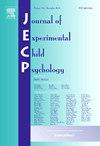Comparing effects of episodic future thinking and cue salience to improve different types of prospective memory in typically developing school-age children
IF 1.8
2区 心理学
Q3 PSYCHOLOGY, DEVELOPMENTAL
引用次数: 0
Abstract
Prospective memory (PM) enables children to remember future intentions and is central to their development. Yet, school-age children face difficulties with remembering planned or assigned tasks and it is therefore crucial to uncover the methods for improving their PM performance. The present study examined the effects of two prominent methods – encoding PM tasks through episodic future thinking (EFT) versus increasing the salience of PM cues – in improving event- and time-based PM of school-age children. In two experiments, 8–12 year-old children (N = 126 and 126 respectively) completed three PM tasks and tasks tapping working memory, inhibition and shifting ability. Children were randomly assigned to the standard PM instruction group, the EFT group, or the cue salience group. In Experiment 1 (event-based PM), the cue salience group outperformed the other two groups in two computer-based PM tasks but not in a more naturalistic PM task. In Experiment 2 (time-based PM), the cue salience group outperformed the other two groups in all PM tasks, and this did not impair ongoing task performance and the cue salience group monitored the time less frequently. Moreover, children with lower shifting abilities showing larger benefits of salient cues on time-based PM. In both experiments, the EFT and standard groups had similar PM performance. These findings suggest that salient PM cues can improve event- and time-based PM in school-age children whereas EFT may not improve PM performance compared to standard encoding. Future research should investigate children’s ability to voluntarily set salient cues for completing daily PM tasks.
比较情景未来思维和线索显著性对典型发展学龄儿童不同类型前瞻记忆的改善效果
前瞻记忆(PM)使儿童能够记住未来的意图,对他们的发展至关重要。然而,学龄儿童在记住计划或分配的任务方面面临困难,因此发现提高他们PM表现的方法至关重要。本研究考察了两种主要方法——通过情景未来思维(EFT)编码PM任务与增加PM线索的显著性——对改善学龄儿童基于事件和时间的PM的影响。在两个实验中,8-12岁儿童(N = 126和126)分别完成了三个PM任务和工作记忆、抑制和转移能力的任务。儿童被随机分配到标准PM教学组、EFT组或提示显著组。在实验1(基于事件的PM)中,线索显著组在两个基于计算机的PM任务中表现优于其他两组,但在一个更自然的PM任务中表现不佳。在实验2(基于时间的PM)中,提示显著性组在所有PM任务中的表现都优于其他两组,这并不影响正在进行的任务表现,提示显著性组监测时间的频率更低。此外,移动能力较低的儿童在基于时间的PM上表现出更大的显著提示益处。在两个实验中,EFT组和标准组的PM表现相似。这些发现表明,显著的PM提示可以改善学龄儿童基于事件和时间的PM,而与标准编码相比,EFT可能不会提高PM的表现。未来的研究应该调查儿童自愿设置显著线索以完成日常PM任务的能力。
本文章由计算机程序翻译,如有差异,请以英文原文为准。
求助全文
约1分钟内获得全文
求助全文
来源期刊

Journal of Experimental Child Psychology
Multiple-
CiteScore
4.50
自引率
7.70%
发文量
190
期刊介绍:
The Journal of Experimental Child Psychology is an excellent source of information concerning all aspects of the development of children. It includes empirical psychological research on cognitive, social/emotional, and physical development. In addition, the journal periodically publishes Special Topic issues.
 求助内容:
求助内容: 应助结果提醒方式:
应助结果提醒方式:


